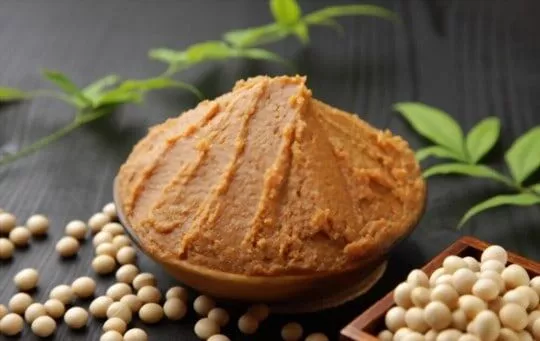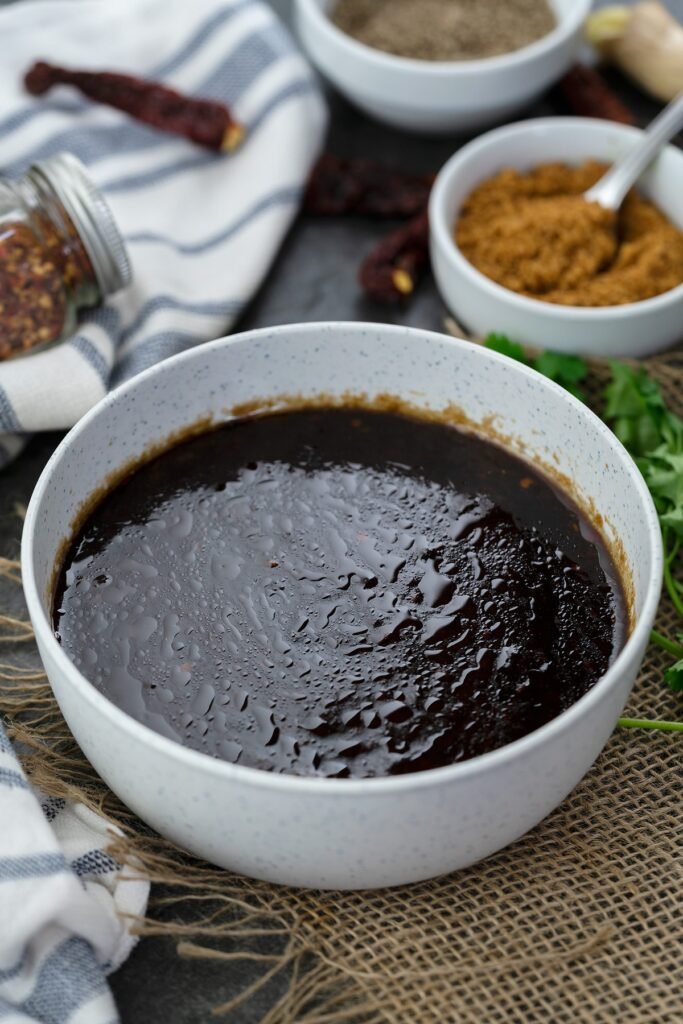Miso paste is a traditional Japanese ingredient that has become increasingly popular in the West.
It’s made from fermented soybeans and is used to add flavor, texture, and umami to dishes.
But what happens if you don’t have miso paste on hand?
Or maybe you’re trying to reduce your sodium intake?
Don’t worry!
There are plenty of substitutes for miso paste that can help you create delicious meals without compromising on taste or nutrition.
In this article, I’ll be discussing eight of the best substitutes for miso paste so that you can enjoy all your favorite recipes without having to buy special ingredients.
Let’s get started!
What is Miso Paste?

Miso paste is a traditional Japanese condiment made from fermented soybeans and rice, barley, or other grains.
It has a salty-sweet flavor with hints of umami that adds depth to any dish.
The fermentation process gives miso its unique and complex flavor profile, making it an essential ingredient in many Japanese dishes such as soups, sauces, dressings, marinades, and more.
Miso paste comes in various colors and textures ranging from white to yellowish brown to dark brown depending on how long it has been aged.
White miso is the mildest tasting while red miso has the most intense flavor due to its long aging period.
The texture can be smooth or chunky depending on the type of grain used in production.
In addition to its use as a condiment or seasoning agent for savory dishes like ramen soup or gyoza dumplings, miso paste can also be used in sweet treats like cakes and pastries adding an extra depth of flavor!
The 8 Best Substitutes For Miso Paste
Miso paste is a key ingredient in many Japanese recipes, but it can be hard to find.
Fortunately, there are some great substitutes that will work just as well.
Here are 8 substitutes for miso paste that you can use in your cooking and baking:
1 – Soy Sauce
https://www.pinterest.com/pin/193514115231080701/Soy sauce is a great substitute for miso paste and can be used when you are looking to add an umami flavor to dishes.
It has a unique salty-sweet flavor that adds richness and depth of flavor in cooked or marinated dishes.
Soy sauce will not provide the same depth of flavor as miso, but it is an ideal alternative when you need an immediate substitution.
It works well in soups, sauces, fried rice, stir-fries, meat marinades and dressings—allowing for a different yet complementary taste compared to miso paste.
Start by adding 1 teaspoon of soy sauce for every tablespoon of miso called for.
Taste before adding more depending on how intense you want the flavor to be.
If your recipe calls for white (shiro) miso paste then opt for light-colored soy sauce over dark-colored varieties so as not to alter the color too much!
2 – Tahini
https://www.pinterest.com/pin/109353097194695467/Tahini is a Middle Eastern condiment made from ground sesame seeds.
It has a slightly nutty, sweet flavor that pairs well with other ingredients like garlic, lemon juice, and spices.
It can be used as an alternative to miso paste in many recipes such as sauces, dressings and marinades.
To substitute tahini for miso paste use equal parts of tahini with an additional pinch of salt if needed.
Tahini can also be added to soups or stews for extra depth of flavor and umami taste similar to what you would get from adding miso paste but without the same complexity.
For example, adding some tahini to tomato soup will give it a creamy texture and nutty flavor which will contrast nicely with the bright acidity of tomatoes.
If you are making tofu scramble or vegan burgers, using tahini instead of miso paste is another tasty way to add more vegan protein and traditional Middle Eastern flavors to your dishes!
3 – Fish Sauce
https://www.pinterest.com/pin/418764465363246563/Fish sauce is a popular ingredient in Southeast Asian and South Asian cuisines that can be used to substitute miso paste.
It’s made by fermenting small fish, usually anchovies, with salt and water.
It has a few similarities to miso paste – its salty, slightly sweet, and savory flavor adds depth to recipes.
Fish sauce can add an umami boost to dishes like soups, sauces, marinades, stir fry, and Thai curries.
Start with adding one teaspoon of fish sauce for every tablespoon of miso paste the recipe calls for and slowly adjust according to taste as desired.
It pairs well with foods like noodles, vegetables, or grilled proteins such as pork chops or chicken breast if you’re looking for something savory but still delicious.
4 – Soybean Paste

Soybean paste, also known as fermented soybean paste, is a type of condiment made from fermented cooked and mashed yellow or black soybeans.
It has a salty taste with a hint of sweetness, and it can be used in many different recipes.
Soybean paste can be used as an alternative to miso paste due to its similar flavor profile and umami-richness.
However, do note that the color of your dish may change when using soybean paste – for example, if you use white miso paste to make clear soup broth but substituted it with dark-colored soybean paste instead, then the color of your broth will turn darker due to the difference in coloring agent.
Aside from soups, you can also use soybean paste in marinades or sauces for extra flavor.
Its thick consistency will add both rich flavors and texture to whatever item you decide to put it on: like grilled meat slices or bean dishes such as edamame.
5 – Tamari

Tamari is a type of fermented soy sauce.
It is made with very little wheat and has a thicker consistency than regular soy sauce, making it perfect for marinades and sauces.
Tamari adds an umami taste to dishes that miso often does.
You can use tamari to substitute miso paste in recipes like stir-fries or ramen bowls that require an added depth of flavor since it becomes more concentrated when cooked at high temperatures.
You should, however, take into consideration the saltiness level of your dish while using tamari.
As tamari is naturally salted and richer in flavor compared to miso, you may need less quantity than what’s required for miso paste for the same recipe outcome.
Generally, one tablespoon of tamari would be enough as a replacement for 2 teaspoons of miso paste in any given recipe
6 – Hoisin Sauce
https://www.pinterest.com/pin/544443042465411880/Hoisin sauce has a deep and sweet taste that can provide an umami-like substitute for miso paste.
Hoisin sauce is made with fermented soybeans, garlic, sesame seeds, sugar and spices.
It’s known as the “barbecue” of sauces in Chinese recipes, but it’s so much more than one type of dish.
The sweet blend goes well with stir-fries, egg rolls, grilled meats and soups alike. Hoisin substitutes admirably for miso when used to braise or glaze tofu or fish.
You can also use it in place of Asian barbecue sauce on grilled or baked chicken wings or ribs.
7 – Marmite

Marmite is a spread made from yeast extract that tastes very similar to miso paste.
It has the same salty, umami flavor but with a slightly deeper and richer taste.
Marmite can be used as an alternative for miso paste in soups, sauces, and marinades.
To get a similar taste to miso paste when using Marmite, use a little less than what you would use of the former; as Marmite has such strong flavor notes it might overpower your dish too much if you’re not careful.
If you want more subtle flavors then just reduce the amounts accordingly – start low and add more Marmite gradually until you get the flavors just right for your dish.
8 – Vegemite

Vegemite is a popular Australian spread made from yeast extract that has a sharp, robust flavor similar to miso paste.
It contains no cholesterol and only minimal amounts of fat and sodium.
It is typically used as a spread on toast or crackers, but it can also be used as an ingredient in dressings, soups, marinades, and sauces.
Its umami flavor makes it a great substitute for miso paste in dips and condiments for sandwiches like burgers or avocado toast.
When using Vegemite instead of miso paste, the general rule is to reduce the amount by up to half.
So if you’re using one tablespoon of miso paste use half a tablespoon (0.50 tablespoons) of Vegemite instead.
You can always add more depending on your taste preferences.
Conclusion
There are many great substitutes for miso paste that will help you create delicious dishes without having to buy special ingredients.
Soy sauce, tahini, fish sauce, soybean paste, tamari, hoisin sauce, marmite, and vegemite are all viable alternatives that can be used to add depth and flavor to your recipes.
Each of these ingredients can be found in most grocery stores and have its own unique taste and texture that can be used to achieve the desired flavor.
When substituting miso paste, it is important to consider the type of dish you are making and adjust the amounts accordingly to ensure you get the desired flavor and texture.

The 8 Best Substitutes For Miso Paste
Ingredients
- Soy Sauce
- Tahini
- Fish Sauce
- Soybean Paste
- Tamari
- Hoisin Sauce
- Marmite
- Vegemite
Instructions
- Pick your favorite substitute from the list above.
- Follow cooking directions for your selected substitute with the proper ratio of ingredients.
Hi, I'm Benjamin. I love cooking, long walks, and my girlfriend! Here you’ll find simple and delicious recipes that you can make in 30 minutes or less.

